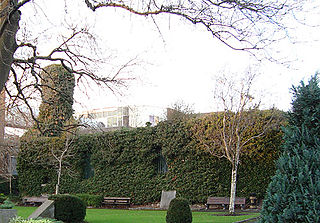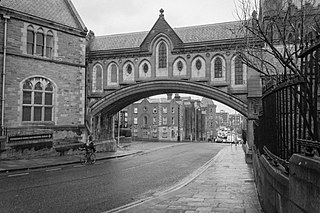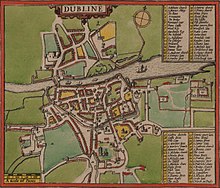
A bomb is an explosive weapon that uses the exothermic reaction of an explosive material to provide an extremely sudden and violent release of energy. Detonations inflict damage principally through ground- and atmosphere-transmitted mechanical stress, the impact and penetration of pressure-driven projectiles, pressure damage, and explosion-generated effects. Bombs have been utilized since the 11th century starting in East Asia.

Christ Church Cathedral, more formally The Cathedral of the Holy Trinity, is the cathedral of the United Dioceses of Dublin and Glendalough and the cathedral of the ecclesiastical province of the United Provinces of Dublin and Cashel in the (Anglican) Church of Ireland. It is situated in Dublin, Ireland, and is the elder of the capital city's two medieval cathedrals, the other being St Patrick's Cathedral.

The Battle of the Yellow Ford was fought in County Armagh on 14 August 1598, during the Nine Years' War in Ireland. An English army of about 4,000, led by Henry Bagenal, was sent from the Pale to relieve the besieged Blackwater Fort. Marching from Armagh to the Blackwater, the column was routed by a Gaelic Irish army under Hugh O'Neill of Tyrone. O'Neill's forces divided the English column and a large earthwork stalled its advance. Bagenal was killed by an Irish musketeer, and scores of his men were killed and wounded when the English gunpowder wagon exploded. About 1,500 of the English army were killed and 300 deserted. After the battle, the Blackwater Fort surrendered to O'Neill. The battle marked an escalation in the war, as the English Crown greatly bolstered its military forces in Ireland, and many Irish lords who had been neutral joined O'Neill's alliance.

The Ballincollig Royal Gunpowder Mills was one of three Royal gunpowder mills that manufactured gunpowder for the British Government. Located in Ballincollig, Cork city, Ireland, largely in what is now the Ballincollig Regional Park, the powder mills were originally opened in 1794 as a private enterprise, before being taken over by the British Government during the Napoleonic Wars.

A gunpowder magazine is a magazine (building) designed to store the explosive gunpowder in wooden barrels for safety. Gunpowder, until superseded, was a universal explosive used in the military and for civil engineering: both applications required storage magazines. Most magazines were purely functional and tended to be in remote and secure locations. They are the successor to the earlier powder towers and powder houses.

The Allegheny Arsenal, established in 1814, was an important supply and manufacturing center for the Union Army during the American Civil War, and the site of the single largest civilian disaster during the war. It was located in the community of Lawrenceville, Pennsylvania, which was annexed by the city of Pittsburgh in 1868.
Events from the year 1597 in Ireland.

There was a St. Kevin's Church in what is now St. Kevin's Park, Camden Row, Dublin, Ireland at least as far as the 13th century. After the Reformation, it became an Anglican church. The original church was replaced around 1750 by a new one, closed in 1912 and now in ruins. Both churches were dedicated to Kevin of Glendalough. There is also a Catholic St. Kevin's Church a short distance away on Harrington Street.

The Dublin quays refers to the two roadways and quays that run along the north and south banks of the River Liffey in Dublin, Ireland. The stretches of the two continuous streets have several different names. However, all but two of the names share the same "quay" designation. The quays have played an important part in Dublin's history.

The Cork gunpowder explosion was a large explosion that took place in Cork, Ireland, on 3 November 1810.
Oriental Powder Company was a gunpowder manufacturer with mills located on the Presumpscot River in Gorham and Windham, Maine. The company was one of the four largest suppliers to Union forces through the American Civil War.
Between 26 November 1972 and 20 January 1973, there were four paramilitary bombings in the centre of Dublin, Ireland. Three civilians were killed and 185 people were injured. No group ever claimed responsibility for the attacks and nobody was ever charged in connection with the bombings. The first bombing in Burgh Quay may have been carried out by former associates of the Littlejohn brothers who were Secret Intelligence Service provocateurs, in a successful attempt to provoke an Irish government clampdown against the Provisional IRA, while the other three bombings were possibly perpetrated by loyalist paramilitaries, specifically the Ulster Volunteer Force (UVF), with British military or intelligence assistance. The UVF claimed in 1993 to have carried out the 1974 Dublin and Monaghan bombings which incurred the greatest loss of life in a single day throughout the 30-year conflict known as the Troubles.

The Magazine Fort is a bastion fort and magazine located within the Phoenix Park, in Dublin, Ireland. Built in 1735, it was occupied by British Armed Forces until 1922 when it was turned over to the Irish Defence Forces after the Anglo-Irish Treaty. The Irish Army continued to operate the site as an ammunition store through the mid-20th century. It was fully demilitarised by the 1980s. The fort is now managed by the Office of Public Works. As of 2015, it was in a derelict state and not open to the public, however, some repairs were undertaken and the site partially opened for "limited guided tours" from 2016.

The Leiden gunpowder disaster was an event in which a ship carrying hundreds of barrels of black powder exploded in the town of Leiden in the Netherlands on 12 January 1807. The disaster killed 151 people and destroyed over 200 buildings in the town.

The Tholsel was an important building in Dublin, Ireland which combined the function of civic hall, guildhall, court, gaol and even for a period acted as parliament house from 1641-48.

Winetavern Street is a street in the medieval area of Dublin, Ireland.
The United States Cartridge Company explosion occurred on July 29 1903, in present-day Lowell, Massachusetts. The explosion of two buildings used to store dynamite and gunpowder killed 22 people and destroyed 13 homes.

The Custom House was a large brick and limestone building located at present-day Wellington Quay in Dublin, Ireland which operated as a custom house, hosting officials overseeing the functions associated with the import and export of goods to Dublin from 1707 until 1791. It also served as the headquarters of the Revenue Commissioners, as a meeting place and offices for the Wide Streets Commission and was said to be Dublin's first dedicated office building.














